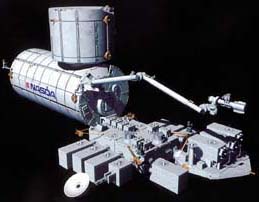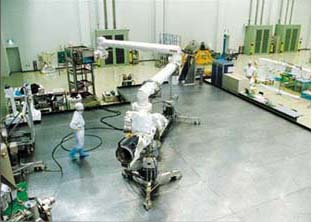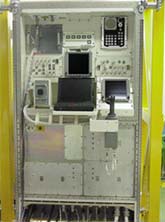
| Kibo's
Manipulator System Undergoing Various Tests |
|
 |
| Conceptual drawing of Kibo showing
an experiment being conducted on the Exposed Facility using the Robot Arm |
 | Three
subsystems composing Kibo's Robot
Arm | Japan is participating
in the International Space Station (ISS) project with the Japanese Experiment
Module (JEM) called "Kibo." This module is composed of the Pressurized Module,
where astronauts can conduct experiments in a one-atmosphere environment, and
the Exposed Facility, where experiments can be conducted in an environment exposed
to space. The Japanese Experiment Module Remote Manipulator System (JEMRMS) is
Japan's first robot arm for actual application. This arm will be able to replace
human extravehicular activities for supporting experiments on the Exposed Facility.
JEMRMS is composed of three subsystems, the Main Arm, the Small Fine Arm,
and the JEMRMS Console. The 10-meter Main Arm is used to exchange payloads (i.e.
experiment equipment) on the Exposed Facility. It has a maximum capacity of seven
tons. The 1.5-meter Small Fine Arm can exchange equipment weighing up to 300 kilograms
and perform tasks requiring dexterity such as tightening bolts. The Small Fine
Arm is mounted at the end of the Main Arm. Astronauts inside Kibo can operate
these two arms by remote control from the JEMRMS Console.
 | Tests
of Main Arm and JEMRMS Console |
 |
 | Main
Arm Assembly Test |  |
| JEMRMS Main Arm's functional test |
The Main Arm Assembly Test was conducted from July to December in 1999.
An Environmental Test, consisting primarily of the Thermal Balance Test and the
Acoustic Test, was conducted during this period. In addition, functional tests
were also conducted to ensure that the Main Arm's electrical, communications,
visual systems (such as cameras), control systems, and safety systems met requirements.
The Thermal Balance Test, a part of the Environmental Test, confirms whether
or not the Main Arm can be controlled properly within the appropriate temperature
range. In space, systems exposed to direct sunlight can reach 200 degrees centigrade
while those in the shade drop to minus 120 degrees centigrade. The Acoustic Test
confirms whether or not the Main Arm will function properly after being subjected
to the severe acoustical environment generated when a shuttle is launched.
The Functional Test subjects the Arm to actual movements. Due to the Earth's
gravity, though, the Arm can only be tested in the horizontal plane. However,
the friction generated as the Arm is moved on the floor makes it impossible to
collect accurate data. This test was therefore conducted in the following manner.
Compressed air was used to float the Arm above a "two- dimensional" table to eliminate
the influence of friction with the floor.
 | JEMRMS
Console Assembly Test |  |
| JEMRMS Console |
The JEMRMS Console Assembly Test began in May 1999 and is still underway.
This test includes environmental testing such as the Thermal Balance Test and
the Acoustic Test as well as functional testing. The Thermal Balance Test confirms
whether the JEMRMS Console inside Kibo can control itself within the appropriate
temperature range. The Acoustic Test confirms whether the Console can endure the
severe acoustic and vibration environment generated when a shuttle is launched.
An Off-Gassing Test was also conducted to ensure that the Console does not
generate any noxious gasses in its normal operation.
JEMRMS components
are planned to be launched by three separate space shuttle flights beginning in
July 2006. |
Last
Updated : October 31, 2002
|
